When it comes to cooking rice, there are two main options: using a rice cooker or a stove. Both methods have their advantages and disadvantages, and the choice largely depends on personal preferences and needs. In this article, we will compare and contrast the rice cooker and stove methods and help you decide which one is the best option for cooking rice.
Key Takeaways:
- Rice can be cooked using a rice cooker or on a stove.
- The choice depends on personal preferences and needs.
- In this article, we will compare and contrast the two methods.
The Advantage of a Rice Cooker
Cooking rice has never been easier than with a rice cooker. The benefits and advantages of using a rice cooker over a stove are undeniable. First and foremost, rice cookers offer convenience, making it possible to cook perfect rice every time with minimum effort. Simply add rice and water, press a button, and voila! No more monitoring the pot or worrying about burning rice.
Another advantage of using a rice cooker is its ease of use. Rice cookers come with clear instructions and are designed to be user-friendly, even for novice chefs. Additionally, rice cookers offer consistent results, ensuring fluffy, perfectly cooked rice every time.
Not only do rice cookers save time and energy, but they also provide a hassle-free cooking experience. Cleaning a rice cooker is a breeze, with most models coming with a non-stick inner pot that can be easily wiped clean. Plus, rice cookers are available in a variety of sizes and styles, making them a versatile addition to any kitchen.
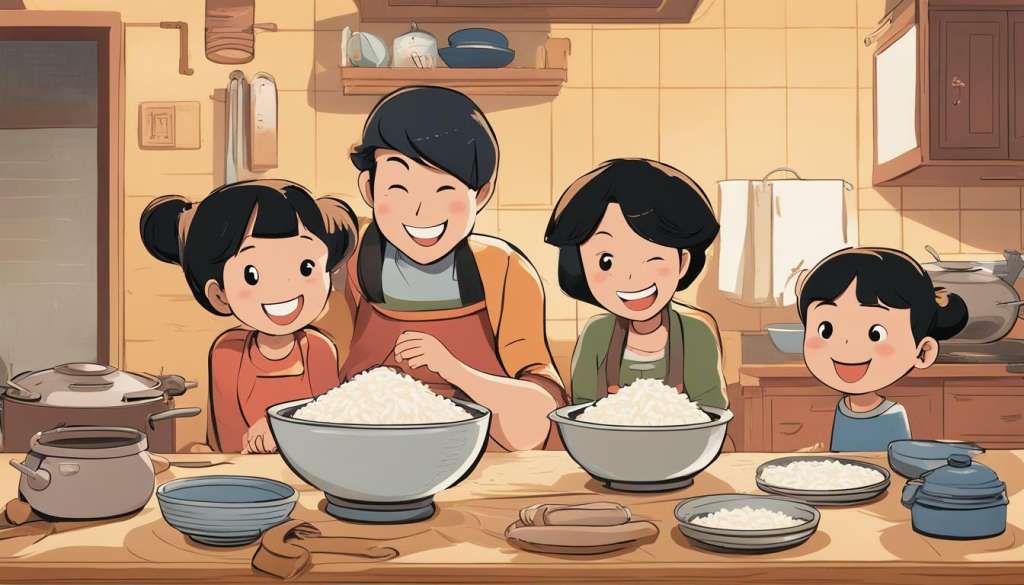
“Rice cookers offer convenience, making it possible to cook perfect rice every time with minimum effort.”
The Advantage of a Rice Cooker: Key Takeaways
- Rice cookers offer convenience and ease of use, making cooking rice a hassle-free experience.
- Rice cookers provide consistent results, ensuring perfectly cooked rice every time.
- Cleaning a rice cooker is easy, with most models coming with a non-stick inner pot that can be easily cleaned.
- Rice cookers are available in a variety of sizes and styles, making them a versatile addition to any kitchen.
The Appeal of Stovetop Cooking
Cooking rice on a stove is the traditional method of making this staple food, and for many people, there’s nothing like the taste and texture of rice cooked on a stovetop. One of the primary advantages of using a stove is the control it offers over the cooking process. With a rice cooker, you’re limited to the preset settings and often have little control over the outcome. However, with the stove, you can adjust the heat and the time to achieve the perfect rice texture and flavor.
Another advantage of cooking rice on a stove is that you can use any type of pot or pan, whereas with a rice cooker, you’re limited to the size and shape of the cooking pot that comes with the appliance. This versatility allows you to make larger or smaller batches of rice, or even mix in other ingredients to create a delicious one-pot meal.
There are also some potential drawbacks to using a rice cooker. While they are convenient, easy to use, and consistently produce fluffy and evenly cooked rice, they can also be more expensive than a conventional stove. Additionally, some people find that the texture of rice cooked in a rice cooker can be too moist or sticky for their taste.
Ultimately, the decision between a rice cooker and a stove for cooking rice comes down to personal preference and needs. If you value convenience, consistency, and ease of use, a rice cooker may be the best option for you. On the other hand, if you prefer the traditional stovetop cooking method, with its increased control over the process and versatility of equipment, then a stove may be the better choice.
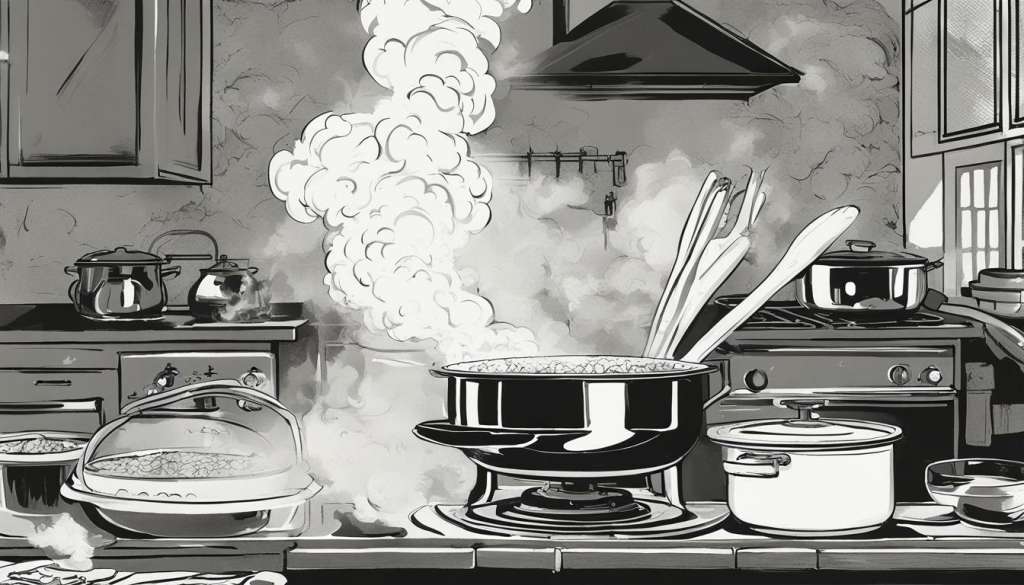
Cooking Rice with a Rice Cooker
Cooking rice with a rice cooker is a simple and convenient process that produces consistent and flavorful results. Here are some step-by-step instructions to guide you:
- Measure the desired amount of rice and rinse it in cold water until the water runs clear. This will help remove excess starch which can make the rice sticky.
- Add the rinsed rice to the rice cooker, along with the appropriate amount of water according to the cooker’s instructions.
- Close the lid and turn on the rice cooker. Depending on the model, the cooker will automatically adjust the temperature and cooking time to ensure that the rice is cooked to perfection.
- Once the rice is done cooking, allow it to sit for a few minutes before fluffing it with a fork and serving.
One of the main advantages of using a rice cooker is that it takes the guesswork out of cooking rice. The cooker will ensure that the rice is cooked evenly and thoroughly, without the need for constant monitoring or stirring. Additionally, many rice cookers have a “keep warm” function, which will maintain the temperature of the rice for several hours after it is finished cooking.
Another benefit of using a rice cooker is that it frees up space on the stove, allowing you to cook other dishes simultaneously. This can be especially helpful when preparing large meals or entertaining guests.
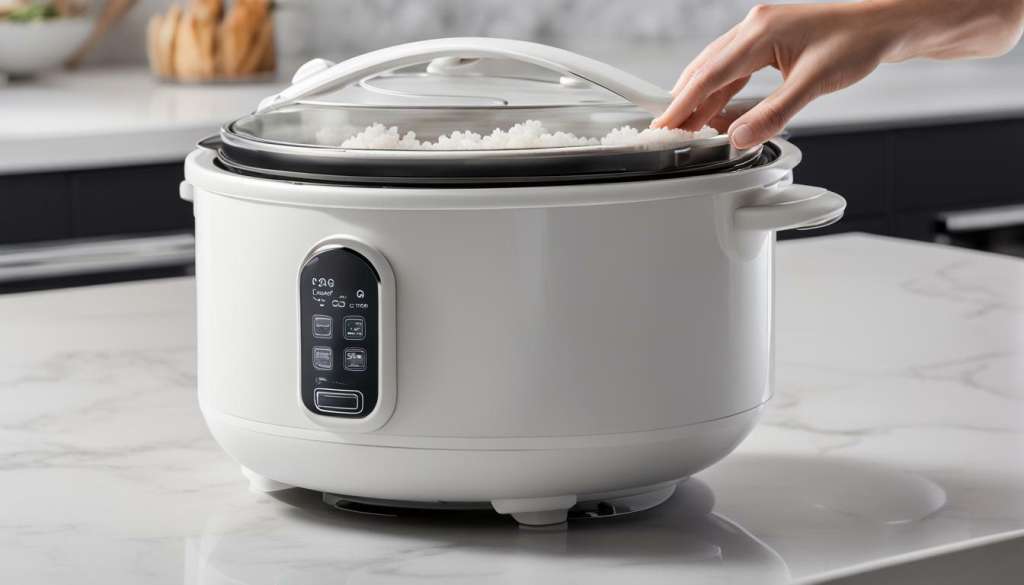
In summary, cooking rice with a rice cooker is a convenient and foolproof method that produces consistent results. While it may require an initial investment, a good quality rice cooker can be a worthwhile addition to any kitchen.
Rice Cooker vs Stove: Cooking Rice on a Stove
While a rice cooker offers convenience and consistent results, many people prefer cooking rice on a stove using the stovetop method. Cooking rice on a stove requires more attention and skill, but it allows for greater control over the cooking process and can result in fluffy, perfectly cooked rice.
Here are the step-by-step instructions for cooking rice on a stove:
| Ingredients | Instructions |
|---|---|
| 1 cup of rice | Rinse the rice in a fine mesh strainer to remove excess starch. Drain well. |
| 2 cups of water | In a medium saucepan, bring the water to a boil over high heat. Add the rice and stir once. |
| Salt (optional) | Add a pinch of salt, if desired. Cover the saucepan tightly with a lid and reduce the heat to low. |
| Cook the rice undisturbed for 18 minutes. Remove the saucepan from the heat and let it sit, covered, for 5 minutes to allow the rice to absorb the moisture and become fluffy. | |
| Fluff the rice with a fork and serve. |
The stovetop method allows for customization, as you can adjust the amount of water, cooking time, and seasoning to your liking. However, it can be time-consuming and requires constant attention to ensure the rice doesn’t burn or stick to the bottom of the pan.
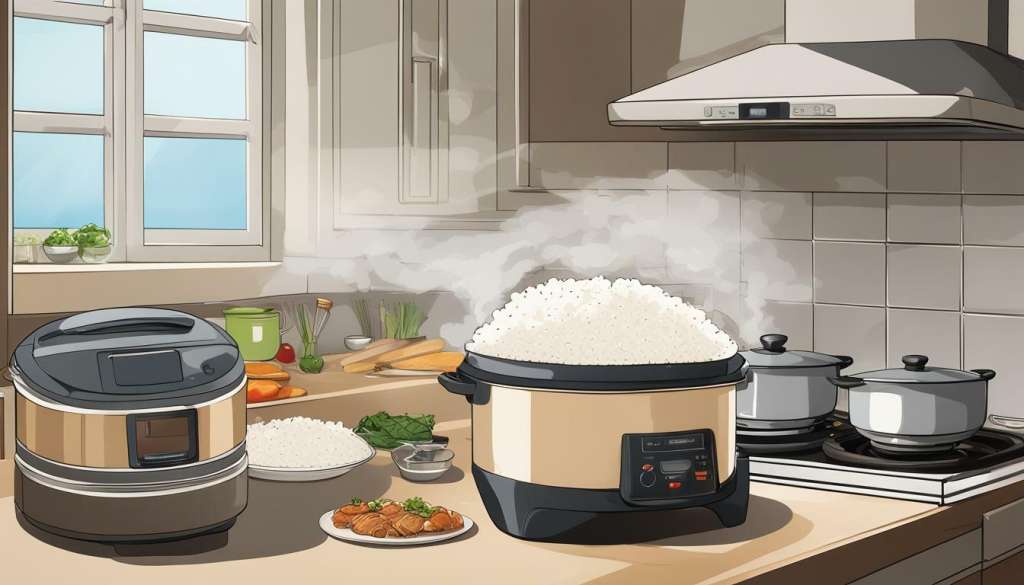
Keep in mind: Cooking rice on a stove may take longer than using a rice cooker, and it can be less energy efficient. However, the stovetop method is a traditional way of cooking rice that many people prefer.
Tips for Perfect Rice on a Stove:
- Use a heavy-bottomed saucepan to prevent burning.
- Fluff the rice with a fork immediately after cooking to prevent clumping.
- Avoid stirring the rice during cooking, as this can release excess starch and make the rice sticky.
Rice Cooker vs Stove: Taste and Texture
One of the most important factors to consider when deciding between a rice cooker and a stove for cooking rice is the taste and texture of the finished product. While both methods can produce delicious and fluffy rice, they each have their unique characteristics that may appeal to different taste preferences.
Moisture Level: Rice cooked in a stove tends to be drier than that cooked in a rice cooker since the latter is designed to retain moisture during the cooking process. This can result in rice that is slightly softer and more tender.
Fluffiness: Stove-cooked rice generally has more separated and fluffy grains than rice cooked in a rice cooker, which can sometimes produce slightly clumpy or sticky rice.
Overall Flavor: This is largely a matter of personal preference, as some people find rice cooked on a stove to have a nuttier and slightly toasted flavor, while others prefer the cleaner, more neutral flavor of rice cooked in a rice cooker.
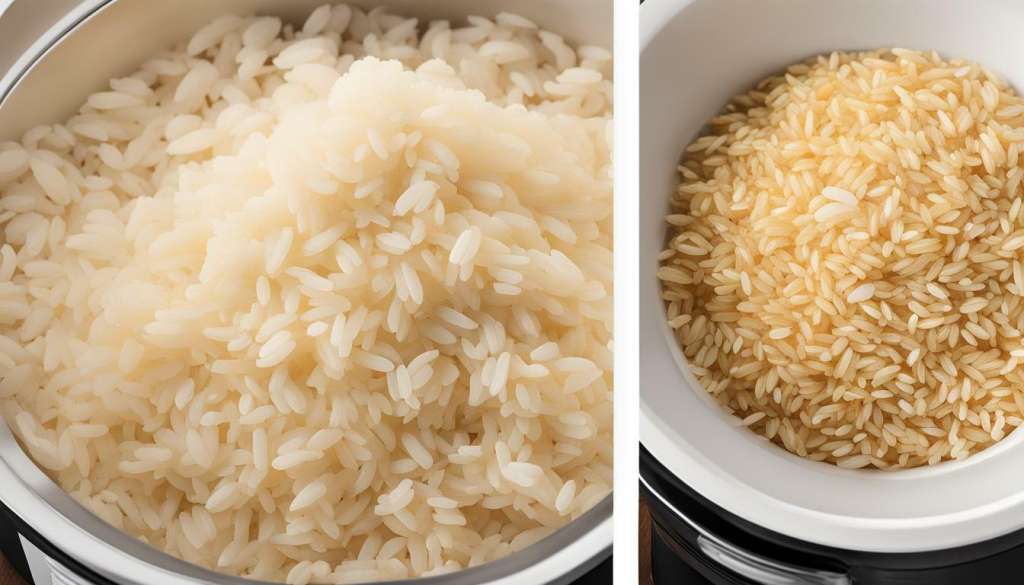
Ultimately, the decision between a rice cooker and a stove for cooking rice may come down to personal taste preferences. If you prefer rice that is slightly softer and more tender, a rice cooker may be the better choice. On the other hand, if you enjoy rice with more separated grains, a stove may be the way to go. In any case, both methods can produce tasty and satisfying rice, so it’s important to consider all factors before making a decision.
The Time and Energy Efficiency of Rice Cookers versus Stove
When deciding whether to use a rice cooker or a stove, one important factor to consider is the time and energy efficiency of each cooking method.
Rice Cooker: Using a rice cooker for cooking rice is often more time-efficient than cooking on a conventional stove because it automates the cooking process. Simply add the rice and water to the rice cooker, set the timer, and wait for perfectly cooked rice. Additionally, rice cookers use less energy and are often more energy-efficient than stovetop cooking methods. This is because rice cookers are specifically designed to cook rice, and their heating elements are optimized to cook rice efficiently.
Stove: Cooking rice on a stove requires more attention and time. You have to constantly monitor the rice as it cooks to ensure it doesn’t boil over or stick to the bottom of the pot. Moreover, the cooking time for rice on a stove is often longer than that of using a rice cooker, particularly if you’re cooking a large batch of rice. This longer cooking time translates into higher energy usage.
Overall, when it comes to time and energy efficiency, using a rice cooker typically offers a more convenient and energy-efficient way of cooking rice.
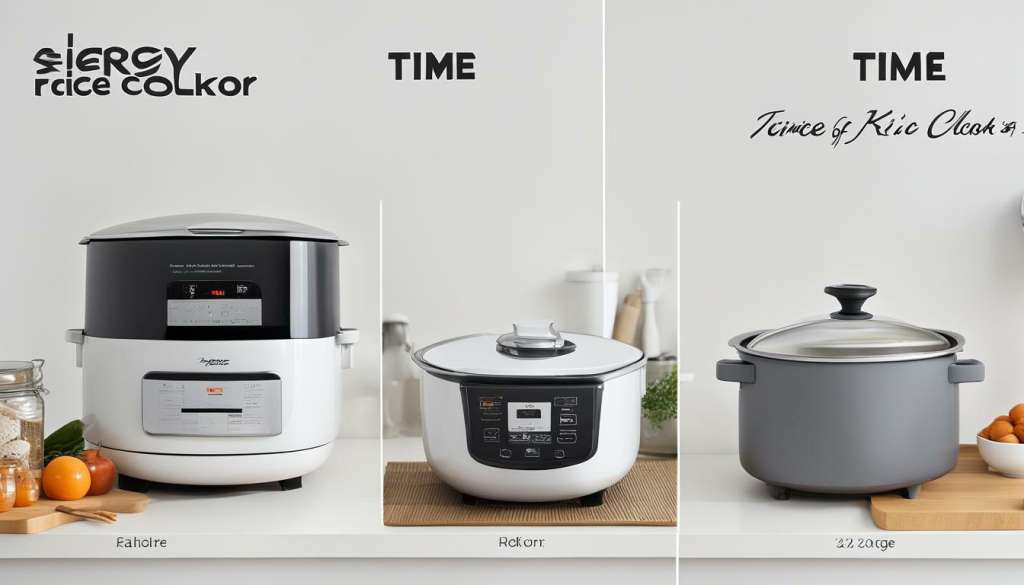
Cleaning and Maintenance
When it comes to cleaning and maintenance, both rice cookers and stoves require attention to keep them functioning properly and safely.
Rice cookers are generally easier to clean than stovetops, as they typically have non-stick coatings that prevent food from sticking and burning onto the surface. Additionally, many rice cookers have removable inner pots that can be easily washed in the sink or dishwasher. However, rice cookers may require periodic descaling to remove mineral buildup, which can affect the cooker’s performance.
Stovetops, on the other hand, can be more difficult to clean due to their exposed burners and grates. Burned-on rice can be particularly challenging to remove, and may require soaking or scrubbing with abrasive cleaners. Additionally, stoves may require more frequent maintenance tasks such as replacing burners, cleaning gas connections, or adjusting the ignition system.
Ultimately, the cleaning and maintenance requirements of rice cookers and stoves will depend on the specific model and how often it is used. It is important to carefully read the manufacturer’s instructions and follow recommended cleaning and maintenance procedures to ensure safe and effective operation.
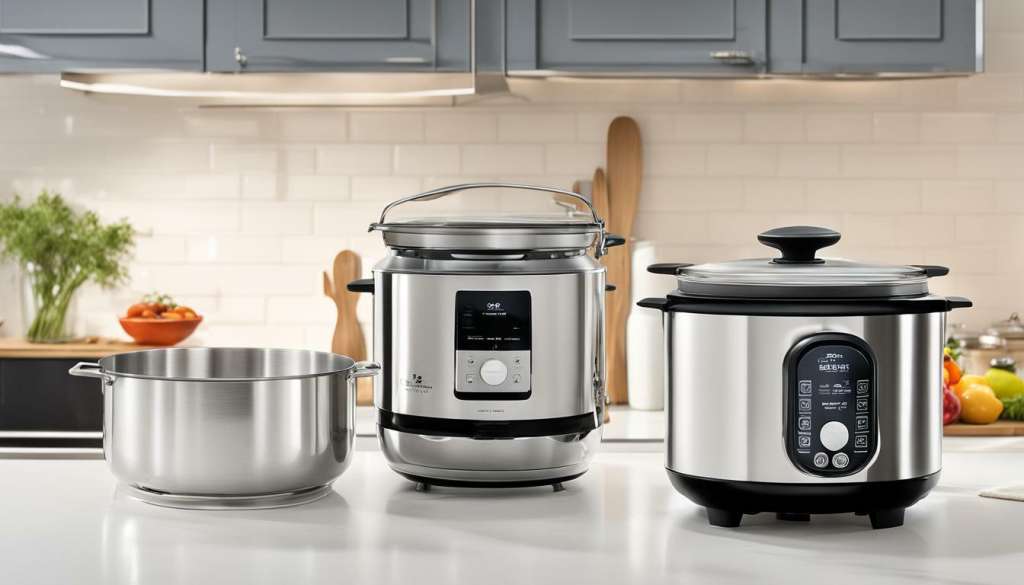
The Versatility and Additional Features of Rice Cookers and Stoves
When deciding between a rice cooker and stove for cooking rice, it is important to consider the versatility and additional features offered by each appliance. While both cooking methods primarily serve the same purpose, there are distinct differences in the capabilities of each.
Rice Cookers: One of the key advantages of using a rice cooker is its versatility. Many modern rice cookers offer various settings that allow for a range of cooking options beyond just rice, including steaming vegetables, making soup, and slow cooking stews. Additionally, some rice cookers come with programmable settings that can be customized to fit specific recipes or preferences. This makes rice cookers a great option for those who want to get more use out of their kitchen appliances.
Stovetops: Cooking rice on a stove provides more flexibility and control over the cooking process. Stovetops can be used for a range of cooking techniques such as sautéing, frying, and boiling. This makes it possible to prepare more complex dishes that may require multiple cooking methods. Additionally, stoves offer greater versatility in terms of the types of pots and pans that can be used, making it easier to switch between recipes.
Overall, the choice between a rice cooker and stove comes down to personal preferences and the specific needs of the user. For those who want more versatility and ease of use, a rice cooker may be the better choice. However, for those who want greater control and flexibility in their cooking, a stove may be the better option.
Additional Features to Consider
When considering the added features of a rice cooker or stove, it’s important to think about what matters most to you. Some additional features to look for include:
| Rice Cookers | Stoves |
|---|---|
| Programmable settings | Ability to cook multiple dishes at once |
| Steaming function | Ability to adjust temperature and cooking methods |
| Soup and stew settings | Compatible with a range of pots and pans |
| Easy to clean surfaces | Ability to control the heat output precisely |
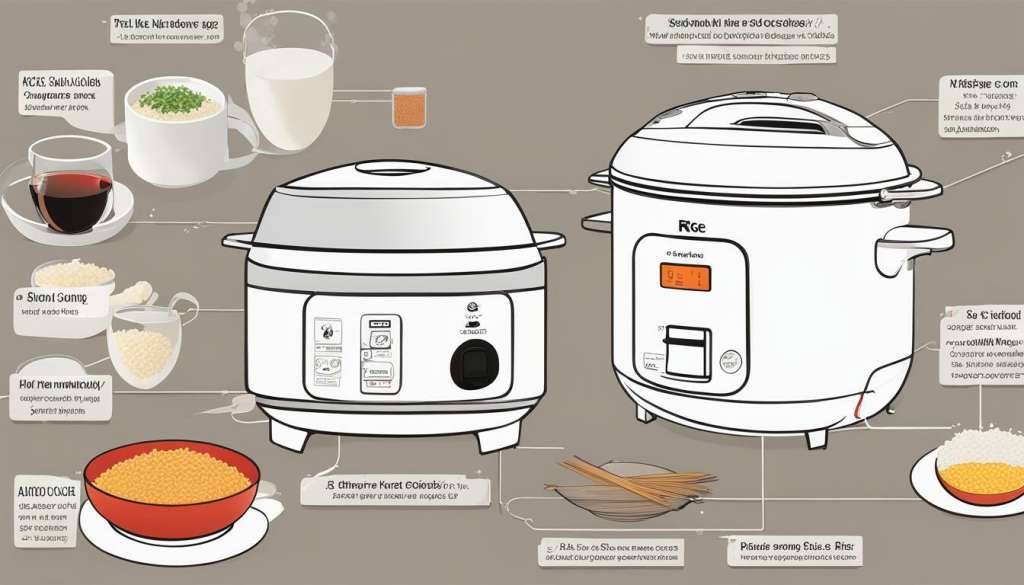
Ultimately, the choice between a rice cooker and stove for cooking rice depends on personal preference and priorities. Consider the features that matter most to you and choose the appliance that best suits your needs.
COST CONSIDERATIONS
When it comes to choosing between a rice cooker and a stove for cooking rice, cost is an important consideration for many people. Rice cookers, while convenient and effective, can be more expensive than a traditional stove. However, the advantages of using a rice cooker over a stove can make the investment worth it in the long run.
One advantage of cooking rice in a rice cooker is that it can save energy and time in the long run. A rice cooker uses less energy than a conventional stove and can cook rice more quickly, saving you money on your energy bill over time. Additionally, rice cookers are designed to cook rice perfectly every time, so you won’t need to waste time and ingredients experimenting with different cooking methods to get the perfect texture and flavor.
While stoves may be a more affordable option initially, the additional time and energy required to cook rice on a stove may end up costing you more in the long run. Additionally, cooking rice on a stove requires more hands-on attention, which can be a disadvantage for those with busy schedules. A rice cooker, on the other hand, allows you to set it and forget it, freeing up time for other tasks.
Overall, the advantages of using a rice cooker over a stove make it a worthwhile investment for rice lovers. While the initial cost may be higher, the energy and time savings in the long run can make a rice cooker more cost-effective and convenient than a stove.
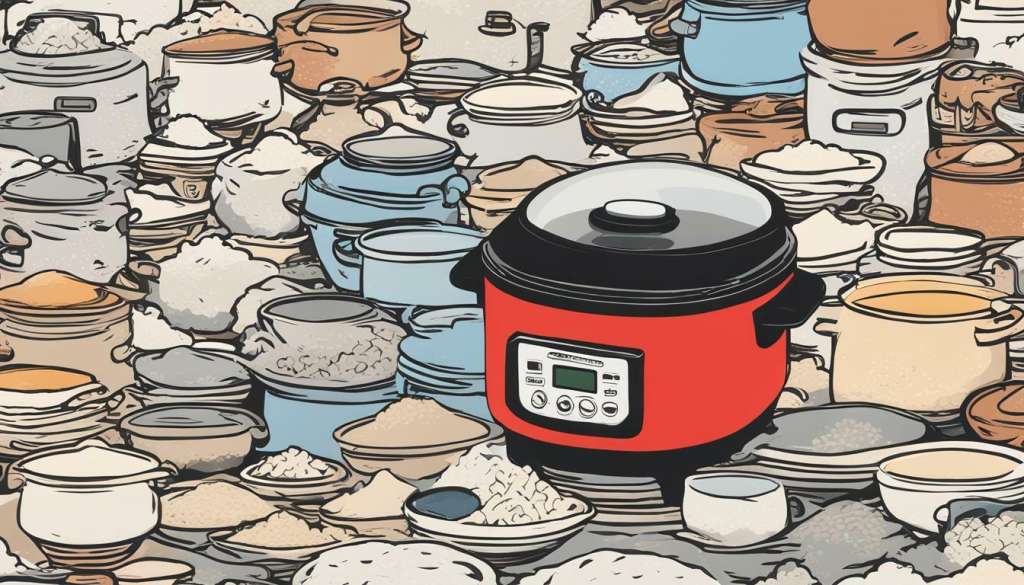
Rice Cooker vs Stove: The Ultimate Comparison
Choosing between a rice cooker and a stove for cooking rice can be a tough decision for many people. Both methods have their unique benefits and drawbacks, making it difficult to decide which one to go for. In this article, we’ve compared the two methods based on various factors, such as ease of use, cooking time, taste, energy efficiency, and versatility. By the end of the article, you’ll have a clear idea of which method suits your needs and preferences better.
The Verdict
So, which one is better? The answer is: it depends. If you’re looking for convenience, ease of use, and consistent results, a rice cooker is the way to go. On the other hand, if you prefer traditional stovetop cooking methods, value control over the cooking process, and enjoy the versatility of using a pot, then cooking rice on a stove might be more your style.
Ultimately, your decision should be based on your personal preferences, lifestyle, and cooking needs. Let’s dive deeper into the comparison between rice cookers and stovetops.
FAQ
Q: Can I use a rice cooker to cook other grains besides rice?
A: Yes, rice cookers are versatile and can be used to cook other grains such as quinoa, barley, and oatmeal.
Q: How long does it take to cook rice in a rice cooker?
A: The cooking time can vary depending on the type of rice and the desired texture, but on average, it takes about 20-30 minutes.
Q: Can I use a rice cooker to steam vegetables?
A: Yes, many rice cookers come with a steaming basket that allows you to steam vegetables while cooking rice.
Q: How do I clean a rice cooker?
A: Most rice cookers have a removable inner pot that can be easily cleaned. Simply wash it with warm soapy water and rinse thoroughly.
Q: Can I leave the rice cooker unattended while it’s cooking?
A: Yes, rice cookers have an automatic shut-off feature that switches off the heat once the rice is cooked, so you can safely leave it unattended.
Q: Is cooking rice on a stove difficult?
A: Cooking rice on a stove requires a little more attention and monitoring compared to using a rice cooker, but with practice, it can become a straightforward process.
Q: Can I cook different types of rice in a rice cooker?
A: Yes, rice cookers are designed to cook various types of rice, including white rice, brown rice, jasmine rice, and more.
Q: Do rice cookers save energy?
A: Yes, rice cookers are generally more energy-efficient than cooking rice on a stove, as they use less electricity and retain heat effectively.
Q: Can I cook rice on a stove without a rice cooker?
A: Absolutely! Many people still prefer cooking rice on a stove as it allows for better control over the cooking process and can achieve different textures.
Q: Are rice cookers expensive?
A: Rice cookers come in a range of prices, from budget-friendly options to more advanced models. It’s possible to find a rice cooker that suits your budget and needs.


